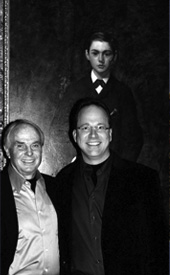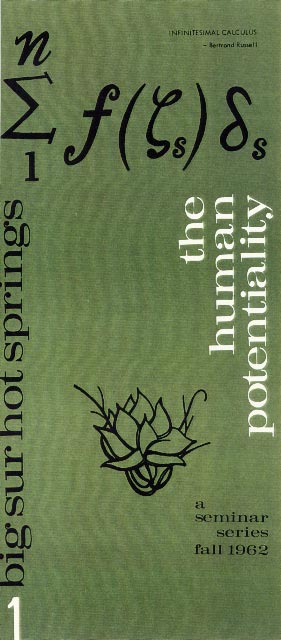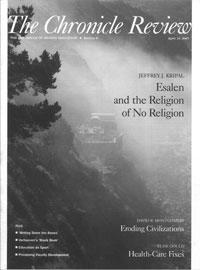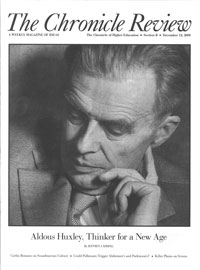Esalen and the Human Potential
“But who are the grown-ups?”
“Don’t ask me,” she answered. “That’s a question for a neurotheologian.”
“Meaning what?” he asked.
“Meaning precisely what it says. Somebody who thinks about people in terms, simultaneously, of the Clear Light of the Void and the vegetative nervous system. The grown-ups are a mixture of Mind and physiology.”Aldous Huxley, Island (1962)
It is my personal opinion that in the science of the future reality will neither be “psychic” nor “physical” but somehow both and somehow neither.
Wolfgang Pauli letter to Abraham Pais
Since Michael Murphy read my Kali's Child in the spring of 1998 and called me late one night in a state of extreme enthusiasm, "armed with a glass of wine and a cell phone," as he likes to put it, I have enjoyed a fruitful and increasingly profound relationship to Murphy and, through him, to the Esalen Institute. Indeed, it was out of this professional and personal—I dare say metaphysical—relationship that I wrote my history of the institute, Esalen: America and the Religion of No Religion. And it is out of the same that, since November of 1998, I have attended, co-directed or directed dozens of symposia through Esalen’s Center for Theory and Research, symposia which have in turn inspired and provided material, collegial networks and ideas for my writing and research.
On December 6, 2007, Mike and I spoke at the Aurora Forum on the campus of Stanford University with Mark Gonnerman. We spoke in the very hall, Cubby Auditorium, where Mike was first inspired to pursue his vision as a young college student. It was the day he heard Prof. Spiegelberg utter the Sanskrit word "Brahman!" For the full story, see chapter 2 of my Esalen. For a transcript and I-Pod download of this Aurora Forum, go to http://auroraforum.stanford.edu/event/esalen. Before the event, we took the photograph below. The boy in the painting is Leland Stanford, Jr., after whom Stanford University is named and to whom it is dedicated. Little Leland died young and was contacted on the other side by the family through mediums, hence the early interest and funding of psychical research at Stanford University.
My on-going duties as the Co-Director of Esalen’s Center for Theory and Research have involved me deeply in the institutional life and future of the institute. Esalen is no longer an object of historical study for me. It is an intimate part of who I am in the world.
Particularly influential have been Mike’s evolutionary panentheism (a philosophy that understands the physical cosmos as the evolving body of God “waking up” into consciousness); Edward Kelly’s neuroscience of an “irreducible mind” beyond the tired dogmas of conventional physicalism; psychotherapist and historian of psychology Adam Crabtree’s work on the history of the unconscious and the practice of trance-work; and the theoretical work of the Swiss quantum theorist Harald Atmanspacher, whose writings on the “Pauli-Jung conjecture” has become a kind of mirror in which I can recognize my own deepest convictions (or hunches). The conjecture? That “mind” and “matter” are two expressions of the same underlying psychophysical reality, that both have, as it were, “split off” from a deeper unity and so commonly reflect or mirror one another in uncannily “coincidental” or “magical” ways. Hence all the synchronicities and “impossible” phenomena of the history of religions in which the mental and material worlds appear to effect or shape one another, often in fantastic ways.
Further Reading and Supporting Texts:
For more on the Center for Theory and Research, including portions of an address I gave on the cultural influence of Esalen on the occasion of the institute’s fiftieth anniversary, go to http://www.esalen.org/ctr
Aldous Huxley, brother of evolutionary biologist Julian Huxley (who, by the way, helped found the biology department here at Rice), grandson of T. H. Huxley, “Darwin’s Bulldog,” psychedelic theorist, and self-confessed spiritual seeker embodied the humanities-sciences interface in extraordinary and still convincing ways. He was also personally key to the conception and founding of Esalen and the human potential movement. For an essay on his continued relevance, see my “An Island in Mind: Aldous Huxley and the Neurotheologian,” for Dinesh Sharma, ed., Psychoanalysis, Culture, and Religions: Essays in Honor of Sudhir Kakar (New Delhi: Oxford University Press, 2014).
For a succinct statement of Michael Murphy’s evolutionary panentheism, see his essay on the same in Loriliai Biernacki and Philip Clayton, eds., Panentheism Across the World’s Traditions (New York: Oxford University Press, 2014). A slightly different version can also be found in Beyond Physicalism, cited immediately below.
For Ed Kelly’s life-work of bringing the sciences into dialogue with the further reaches of the human spirit, see his two-volume master-work as editor and lead writer: Edward Kelly and Emily Williams Kelly, eds., Irreducible Mind: Toward a Psychology of the 21st Century (Rowman & Littlefield, 2006) and Edward Kelly, Adam Crabtree, and Paul Marshall, eds., Beyond Physicalism: Toward Reconciliation of Science and Spirituality (Rowman & Littlefield, 2015).
For Adam Crabtree’s historical and theoretical work, see especially Adam Crabtree, From Mesmer to Freud: Magnetic Sleep and the Roots of Psychological Healing (New Haven: Yale University Press, 1993) and Memoir of a Trance Therapist: Hypnosis and the Evocation of Human Potentials (Friesenpress, 2014).
For a cogent series of essays on the philosophical position that emerged from the quarter-century friendship between Wolfgang Pauli and C. G. Jung, see Harald Atmanspacher and Christopher A. Fuchs, eds., The Pauli-Jung Conjecture: And Its Impact Today (Imprint Academic, 2014).
Esalen's long-running CTR symposia series was affectionately called Sursem (for either "[Big] Sur Symposium" or "Survival Seminar"), a collective of scientists, philosophers, scholars of religion, and human potential figures that included Murphy, Kelly, Crabtree and Atmanspacher. For a brief history of Sursem and some of its challenges to the consensus materialism of our present intellectual culture, see my "Mind Matters: Esalen's Sursem Group and the Ethnography of Consciousness," for Ann Taves and Courtney Bender, eds., What Matters? Ethnographies of Value in a (Not So) Secular Age (New York: Columbia University Press, 2012).
 |
   |

